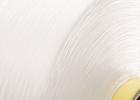PET Polyester: Versatile & Ideal For Coatings
Key Features of PET Polyester"
- Good chemical resistance
- Hydrophobic
- Good abrasion resistance
- Good tensile strength
History
PET is the most common thermoplastic polymer in the polyester family. The first US commercial polyester fiber production was completed in 1953 by DuPont™ under the name Dacron®. It is the same polymer resin utilized in the plastic bottle industry.
Composition
PET is produced in a melt spun and drawing process. The three processes utilized in the production of PET fiber are polymerization, melt-spinning, and drawing or hot stretching the fibers based upon their elongation requirements.
FIBER-LINE® Enhancing Processes for PET:
FIBER-LINE® PET Polyester Products:
Manufacturers
Fiber-Line® works with a variety of PET Polyester suppliers
Common Types & Deniers
High Tenacity
Standard Shrink
Low Shrink
Ultra-low shrink
Deniers: 50-3000
PET Polyester Fiber Bare Fiber Performance
PET Polyester Fiber Data
High Tenacity
| Property | UOM | Value |
|---|---|---|
| Breaking Tenacity | g/d | 9.3 |
| Specific Gravity | Ratio | 1.38 |
| Elongation @ Break | % | 14.6 |
| Tensile Modules | g/d | 120 |
| Moisture Regain* | % | 0.4 |
| Creep** | % | 1.0 - 12.0 |
| Skrinkage*** | % | 8.0 - 15.0 |
| Melt Point | ℃ | 256 |
Low Shrink
| Property | UOM | Value |
|---|---|---|
| Breaking Tenacity | g/d | 8.4 |
| Specific Gravity | Ratio | 1.38 |
| Elongation @ Break | % | 19.5 |
| Tensile Modules | g/d | 70 |
| Moisture Regain* | % | 0.4 |
| Creep** | % | 1.0 - 12.0 |
| Shrinkage*** | % | 3.0 - 8.0 |
| Melt Point | ℃ | 256 |
* Equilibrium moisture regain @ 55% RH ** Creep @ 40%-58% ultimate tensile strength *** Shrinkage in dry air @ 177 C for 30 minutes
This data is provided for informational purposes only, and does not constitute a specification. FIBER-LINE makes no warranty, express or implied, that the product conforms to these values. Contact your FIBER-LINE representative for exact product details which conform to your specific requirements.




